生物分离与界面分子机制创新特区研究组(18T7组)卿光焱研究员在特异性识别唾液酸及唾液酸糖链方面取得新进展。
位于糖链末端的唾液酸致密地附着在哺乳细胞表面,在各种生理和病理过程中发挥重要和独特的作用,例如神经发育、细胞-细胞相互作用、自身免疫和癌症等等。然而,由于唾液酸种类之间的细微结构差异以及糖链的复杂组成成分,唾液酸糖链的精确识别是一大难题。我组提出了一种基于芘-共轭组氨酸(PyHis)超分子凝胶的荧光动态响应体系。受π-π堆叠和分子间氢键驱动,PyHis表现出强大的自组装能力并形成稳定的凝胶。我们发现,N-乙酰氨氨酸(一种典型唾液酸)的引入可以阻止这种自组装过程,而其他单糖或唾液酸类似物则对自组装过程没有显著影响。有趣的是,唾液酸糖链对凝胶形成也有明显的抑制作用,这突出了凝胶动态响应体系的高选择性。机理研究表明,唾液酸或唾液酸化糖链可以通过氢键相互作用与堆叠在一起的两个PyHis分子相互作用,从而阻止凝胶因子的有序积聚。值得注意的是,唾液酸的特异性识别效应并非在单分子水平上观察到的,而是在超分子水平上实现的,这表明了超分子自组装体系在生物分子识别和响应方面的独特优势。该研究结果表明,超分子凝胶在组装工程、再生医学、肿瘤细胞分选和肿瘤诊断等领域具有广阔的应用前景。
Self-assembly gel-based dynamic response system for specific recognition of N-acetylneuraminic acid
Xue Wang, Shengxu Qian, Dongdong Wang, Cunli Wang, Haijuan Qin, Lang Peng, Wenqi Lu, Yahui Zhang and Guangyan Qing*
Journal of Materials Chemistry B 2021, 9, 4690; DOI: 10.1039/D1TB00627D

Sialic acids located at the terminal end of glycans are densely attached to cell surfaces and play crucial and distinctive roles in a variety of physiological and pathological processes, such as neural development, cell-cell interactions, autoimmunity and cancers. However, due to the subtle structural differences of sialic acid species and the complicated composition of glycans, the precise recognition of sialylated glycans is a difficult question. Here, we propose a fluorescent dynamic response system based on a pyrene-conjugated histidine (PyHis) supramolecular gel. Driven by π-π stacking and intermolecular hydrogen bonds, PyHis exhibits strong self-assembly ability and forms stable gels. We find that introduction of N-acetylneuraminic acid (a typical sialic acid) could prevent this self-assembly process, while other monosaccharides or sialic acid analogs have no significant effect on it. Interestingly, a sialylated glycan also has a remarkable inhibitory effect on the gel formation, which highlights the high selectivity of the gel dynamic response system. Mechanism analysis reveals that the sialic acid or sialylated glycan could interact closely with two PyHis molecules stacked together in the assemblies via hydrogen bonding interactions, thereby preventing the ordered accumulation of the gelators. It is worthy noting that the high-efficiency sialic acid recognition effect is not observed at the single-molecule level but at the supramolecular level, indicating the unique superiority of supramolecular self-assembly system in biomolecular recognition and response. This work shows the promising prospects of supramolecular gels in assembly engineering, regenerative medicine, tumor cell sorting and cancer diagnosis.